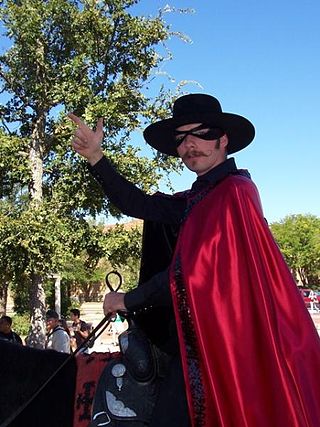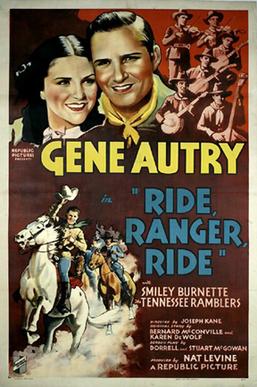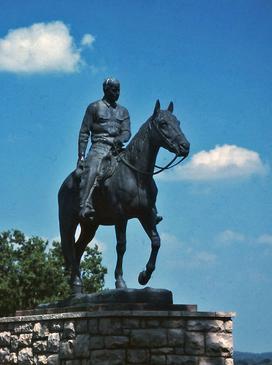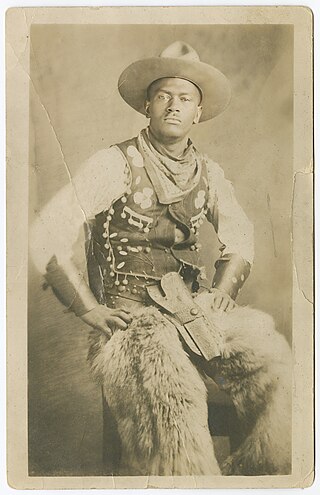Related Research Articles

The Pony Express was an American express mail service that used relays of horse-mounted riders between Missouri and California. It was operated by the Central Overland California and Pikes Peak Express Company.

Equestrianism, commonly known as horse riding or horseback riding, includes the disciplines of riding, driving, and vaulting. This broad description includes the use of horses for practical working purposes, transportation, recreational activities, artistic or cultural exercises, and competitive sport.

A cowboy is an animal herder who tends cattle on ranches in North America, traditionally on horseback, and often performs a multitude of other ranch-related tasks. Cattle drives ensure the herds health in finding pasture and bring them to market. The historic American cowboy of the late 19th century arose from the vaquero traditions of northern Mexico and became a figure of special significance and legend. A subtype, called a wrangler, specifically tends the horses used to work cattle. In addition to ranch work, some cowboys work for or participate in rodeos. Cowgirls, first defined as such in the late 19th century, had a less well-documented historical role, but in the modern world work at identical tasks and have obtained considerable respect for their achievements. Cattle handlers in many other parts of the world, particularly in South America and stockmen and jackaroos in Australia, perform work similar to the cowboy.

The vaquero is a horse-mounted livestock herder of a tradition that has its roots in the Iberian Peninsula and extensively developed in Mexico from a methodology brought to the Americas from Spain. The vaquero became the foundation for the North American cowboy, in Northern Mexico, Southwestern United States, and Western Canada.

Charro, in Mexico, is historically the horseman from the countryside, the Ranchero, who lived and worked in the haciendas and performed all his tasks on horseback, working mainly as vaqueros and caporales, among other jobs. He was renowned for his superb horsemanship, for his skill in handling the lasso, and for his unique costume designed specially for horseback riding. Today, this name is given to someone who practices charreada, considered the national sport of Mexico which maintains traditional rules and regulations in effect from colonial times up to the Mexican Revolution.

Chaps are sturdy coverings for the legs consisting of leggings and a belt. They are buckled on over pants with the chaps' integrated belt, but unlike trousers, they have no seat and are not joined at the crotch. They are designed to provide protection for the legs and are usually made of leather or a leather-like material. Their name is a shortened version of the Spanish word chaparajos. Chaparajos were named after the chaparral, from which they were designed to protect the legs while riding on horseback. Like much of western American horse culture, the origin of chaparajos was in the south of Spain, from which it then passed on to the part of New Spain that later became Mexico, and has been assimilated into cowboy culture of the American West. They are a protective garment to be used when riding a horse through brushy terrain. In the modern world, they are worn for both practical work purposes and for exhibition or show use. Chaps have also been adopted for use on motorcycles, particularly by cruiser-style motorcycle riders.

Enos Edward "Yakima" Canutt was an American champion rodeo rider, actor, stuntman, and action director. He developed many stunts for films and the techniques and technology to protect stuntmen in performing them.

Lane Chandler was an American actor specializing mainly in Westerns.

Aimé Félix Tschiffely was a Swiss-born, Argentine professor, author, and adventurer. A. F. Tschiffely wrote a number of books, most famously Tschiffely's Ride (1933) in which he recounts his solo journey on horseback from Argentina to Washington D.C.. Tschiffely was a household name in the United States during the 1930s, meeting with President Calvin Coolidge, appearing in National Geographic Magazine and earning a living from his popular book sales.

The Masked Rider is the primary mascot of Texas Tech University. It is the oldest of the university's mascots still in existence today. Originally called "Ghost Rider", it was an unofficial mascot appearing in a few games in 1936 and then became the official mascot with the 1954 Gator Bowl. The Masked Rider has led the team onto the field at nearly every football game since. It is the nation's first school mascot to feature a live horse at a football game, ahead of Florida State's Chief Osceola and Renegade and 25 years before USC's Traveler and all other such mascots in existence today.

Raider Red is one of the mascots of Texas Tech University. The university's primary mascot is The Masked Rider who rides a live horse. Raider Red is used at events where The Masked Rider is not allowed or would not be appropriate.

A bridle path, also bridleway, equestrian trail, horse riding path, ride, bridle road, or horse trail, is a trail or a thoroughfare that is used by people riding on horses. Trails originally created for use by horses often now serve a wider range of users, including equestrians, hikers, and cyclists. Such paths are either impassable for motorized vehicles, or vehicles are banned. The laws relating to allowable uses vary from country to country.

A saddle is a supportive structure for a rider of an animal, fastened to an animal's back by a girth. The most common type is equestrian. However, specialized saddles have been created for oxen, camels and other animals. It is not known precisely when riders first began to use some sort of padding or protection, but a blanket attached by some form of surcingle or girth was probably the first "saddle", followed later by more elaborate padded designs. The solid saddle tree was a later invention, and though early stirrup designs predated the invention of the solid tree, the paired stirrup, which attached to the tree, was the last element of the saddle to reach the basic form that is still used today. Today, modern saddles come in a wide variety of styles, each designed for a specific equestrianism discipline, and require careful fit to both the rider and the horse. Proper saddle care can extend the useful life of a saddle, often for decades. The saddle was a crucial step in the increased use of domesticated animals, during the Classical Era.
A saddle tramp is a person who wanders from place to place on horseback.

Texas Tech University traditions are an important part of the culture of Texas Tech University.

Ride Ranger Ride is a 1936 American Western film directed by Joseph Kane and starring Gene Autry, Smiley Burnette, and Kay Hughes. Based on a story by Bernard McConville and Karen DeWolf, and a screenplay by Dorrell and Stuart E. McGowan, the film is about a Texas Ranger working undercover to protect an Army wagon train full of ammunition and supplies. The Army doesn't believe him at first, until the Comanche arrive.
Cowboy polo is a variation of polo played mostly in the western United States. Like regular polo, it is played in chukkas (periods) with two teams on horses who use mallets to hit a ball through a goal. It differs from traditional polo in that five riders make up a team instead of four, western saddles and equipment are used, and the playing field is usually a simple rodeo arena or other enclosed dirt area, indoors or out. Also, instead of the small ball used in traditional polo, the players use a large red rubber medicine ball and use mallets with long fiberglass shafts and hard rubber heads.

Riding into the Sunset is a bronze sculpture by Electra Waggoner Biggs, depicting Will Rogers on his horse, Soapsuds. There are four castings, located in Fort Worth, Texas, Claremore, Oklahoma, Lubbock, Texas, and Dallas, Texas.

Black cowboys in the American West accounted for up to an estimated 25% of cowboys "who went up the trail" from the 1860s to 1880s and substantial but unknown percentage in the rest of the ranching industry, estimated to be at least 5,000 workers according to recent research.
Annie "Mesannie" Wilkins (1891–1980) was a 63-year-old farmer who made national headlines by traveling over 5,000 miles across the United States from Maine to California with a retired race horse named Tarzan, a packhorse named Rex and a dog named Depeche Toi.
References
- ↑ Oxford English Dictionary. n. saddle tramp.
- ↑ Curtin, Kevin (October 24, 2016). "ATX's Midwestern honky-tonkers saddle-up for Adrian Quesada". The Austin Chronicle. Retrieved July 19, 2024.
- ↑ Saddle Tramps. Texas Tech University. History & Traditions.